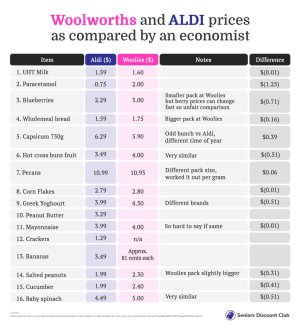Do budget supermarkets even exist anymore? Expert compares Woolies, ALDI prices
- Replies 24
As the cost of living continues to rise, many Australians are finding that their weekly grocery bills are taking up a larger portion of their budget.
The latest inflation data shows an alarming 9.2 per cent increase in the cost of supermarket items over the past year.
Money is a large part of our decisions when it comes to shopping, and although some of us have become savvy in our quest to save money, the question remains: where should Australians shop to get the most bang for their buck?
This is precisely what one expert set out to find when they decided to compare the prices of similar items from Woolworths and ALDI.
‘I used to just buy a lot at Woolworths online but now I try to go to ALDI a bit more. Partly to save money, partly to get a bit of variety from the standard Woolies items, partly to get my hands on some exciting special buys,’ Economist Jason Murphy said.
(Interesting SDC side note here: @Maddison Dwyer said she’s been doing the opposite lately since she found that Woolies’ prices are ‘pretty much the same’ as ALDI’s. Meanwhile, our editor @April Bradford admitted she’s completely stopped shopping at ALDI.)
‘I’ve got two little kids, and my grocery bills are definitely higher than they were back in the day. My partner and I used to drop $200 on a shop, now it’s often $300 or more.’
‘I’m not saying we’re trying to minimise what we spend. We could eat just rice and lentils and live a lot more cheaply. I am saying that if I can buy the things I want for less, I want to do that — including pecans, red meat, wasteful snack foods etc.’

And so, James shared the results of a recent trip to his local ALDI, which revealed a total spend of $247.03.
Ever the curious individual, he thought to compare prices at Woolworths using the retail giant’s website.
‘ALDI is cheaper on most things,’ he found. ‘About 50 cents less on some items that are easy to compare, like a 150-gram block of Manchego cheese, or a nine-pack of mini hot cross buns.’
‘But only one cent cheaper on some basic things, like a 700-gram pack of Cornflakes (comparing Woolies home brand at $2.80 to ALDI’s brand at $2.79), or a litre of basic UHT milk.’
‘There was one item where ALDI is way cheaper: paracetamol for 75 cents (the cheapest one at Woolworths is $2).’
But the keyword being ‘most’, he also found some items where Woolies managed to have an edge over ALDI.
‘Pecans, for example. I like to eat pecans and I thought ALDI was cheap at $10.99 for 400 grams, but Woolworths is selling the same weight for $10.93. The capsicums at Woolies were less too, if you buy the Odd Bunch,’ he said, but with the caveat that he didn’t check prices at Woolies the same day he shopped at ALDI. (‘Fresh food prices can bounce around,’ he said of the disclaimer.)
Still, even to his expert eye, James found that there’s a lot more to comparing prices between Woolworths and ALDI than looking at the cost alone.
Most interestingly, what led him to his conclusion was some good ol’ peanut butter!
‘There’s weight differences between the packages. For example, the Farmer’s Union Greek Yoghurt they sell at ALDI is 930g, not a kilogram like the pack they sell at Woolies. But that wouldn’t be hard to control for, it’s just maths,’ he said.
‘The really hard part was controlling for quality. My confidence (that) I could compare the two supermarkets totally fell apart when I got to peanut butter. I eat so much peanut butter I can tell the difference between brands. I’m like a peanut butter connoisseur, I guess.’
James said his preferred peanut butter brand (‘I consider [it] the best’) at Woolies was Mayver’s 375g Dark Roasted Peanut Butter ($5.80).
At ALDI however, he found a cheaper alternative among the store’s offerings that cost just $3.29 for the same weight.
‘But is the ALDI one comparable to the Mayver’s?’ he asked.
‘No way! My refined peanut butter palette says there’s no comparison, but to be fair, I checked the ingredient list and both of them are just made of peanuts and sea salt.’
‘On paper, they’re identical products, but to me? No way.’
The observation led him to question whether or not buying things for cheaper was always the great thing it was always cut out to be.
‘I looked through all the other things on the list, and the same could be true for them. The items look the same – but are they? Manchego cheese? Who can say if the quality is the same?’ he said.
‘Mayonnaise is another classic one: you can make it with fancy egg yolk or cheap canola oil and still call it mayo.’
‘Even the pecans could be different in terms of freshness, or fat and protein content.
‘The ALDI yoghourt pouch that I fed to my kid while we were still in ALDI to stop him crying? It probably has a totally different protein, fat and sugar ratio to the ones in Woolworths.’
On the other hand, James was also quick to stress he wasn’t saying ALDI products were automatically worse because they’re cheaper.
‘I’ve eaten ALDI’s Choceur chocolate and I’ve eaten Cadbury’s and the ALDI stuff is so much better there’s no comparison. It’s more akin to Lindt or Whittaker’s,’ he said.
After coming to his peanut butter-borne realisation, James admitted that comparing ALDI and Woolworths prices without taking a look at the ‘subtle differences between … items’ can be a bit of a ‘nightmare’.
So what should people who find themselves in the same dilemma do?
Well, James has this piece of advice to offer: ‘I guess the trick is to not be fussy. If I’m willing to stop buying my favourite peanut butter, I can save $2.50 a jar.’
‘But where do I stop? I don’t want to end up eating crappy homebrand stuff that tastes bad and is bad for you just because of a bit of inflation.’
In other words, cheaper isn’t always better.

That said, it would be remiss of us not to acknowledge the fact that for some, cheaper is the only option, which is why we’re very much keen on finding ways seniors can save amid an intense cost-of-living crisis.
It’s also not the first time someone has gone through the motions to get into the nitty-gritty of retailer price wars. Journalist Ben Graham also included Coles in his analysis last year, so you might want to check it out.
So, what are your thoughts on this? In your experience, does ALDI’s range of items cost less compared to other supermarkets?
Do you agree that there’s a lot more to comparing prices than just looking at the cost of goods?
Tell us your opinions in the comments section below!
The latest inflation data shows an alarming 9.2 per cent increase in the cost of supermarket items over the past year.
Money is a large part of our decisions when it comes to shopping, and although some of us have become savvy in our quest to save money, the question remains: where should Australians shop to get the most bang for their buck?
This is precisely what one expert set out to find when they decided to compare the prices of similar items from Woolworths and ALDI.
‘I used to just buy a lot at Woolworths online but now I try to go to ALDI a bit more. Partly to save money, partly to get a bit of variety from the standard Woolies items, partly to get my hands on some exciting special buys,’ Economist Jason Murphy said.
(Interesting SDC side note here: @Maddison Dwyer said she’s been doing the opposite lately since she found that Woolies’ prices are ‘pretty much the same’ as ALDI’s. Meanwhile, our editor @April Bradford admitted she’s completely stopped shopping at ALDI.)
‘I’ve got two little kids, and my grocery bills are definitely higher than they were back in the day. My partner and I used to drop $200 on a shop, now it’s often $300 or more.’
‘I’m not saying we’re trying to minimise what we spend. We could eat just rice and lentils and live a lot more cheaply. I am saying that if I can buy the things I want for less, I want to do that — including pecans, red meat, wasteful snack foods etc.’

ALDI items generally were more cheaper by a few cents compared to their Woolies counterparts. Image Credit: Seniors Discount Club
And so, James shared the results of a recent trip to his local ALDI, which revealed a total spend of $247.03.
Ever the curious individual, he thought to compare prices at Woolworths using the retail giant’s website.
‘ALDI is cheaper on most things,’ he found. ‘About 50 cents less on some items that are easy to compare, like a 150-gram block of Manchego cheese, or a nine-pack of mini hot cross buns.’
‘But only one cent cheaper on some basic things, like a 700-gram pack of Cornflakes (comparing Woolies home brand at $2.80 to ALDI’s brand at $2.79), or a litre of basic UHT milk.’
‘There was one item where ALDI is way cheaper: paracetamol for 75 cents (the cheapest one at Woolworths is $2).’
But the keyword being ‘most’, he also found some items where Woolies managed to have an edge over ALDI.
‘Pecans, for example. I like to eat pecans and I thought ALDI was cheap at $10.99 for 400 grams, but Woolworths is selling the same weight for $10.93. The capsicums at Woolies were less too, if you buy the Odd Bunch,’ he said, but with the caveat that he didn’t check prices at Woolies the same day he shopped at ALDI. (‘Fresh food prices can bounce around,’ he said of the disclaimer.)
Still, even to his expert eye, James found that there’s a lot more to comparing prices between Woolworths and ALDI than looking at the cost alone.
Most interestingly, what led him to his conclusion was some good ol’ peanut butter!
‘There’s weight differences between the packages. For example, the Farmer’s Union Greek Yoghurt they sell at ALDI is 930g, not a kilogram like the pack they sell at Woolies. But that wouldn’t be hard to control for, it’s just maths,’ he said.
‘The really hard part was controlling for quality. My confidence (that) I could compare the two supermarkets totally fell apart when I got to peanut butter. I eat so much peanut butter I can tell the difference between brands. I’m like a peanut butter connoisseur, I guess.’
James said his preferred peanut butter brand (‘I consider [it] the best’) at Woolies was Mayver’s 375g Dark Roasted Peanut Butter ($5.80).
At ALDI however, he found a cheaper alternative among the store’s offerings that cost just $3.29 for the same weight.
‘But is the ALDI one comparable to the Mayver’s?’ he asked.
‘No way! My refined peanut butter palette says there’s no comparison, but to be fair, I checked the ingredient list and both of them are just made of peanuts and sea salt.’
‘On paper, they’re identical products, but to me? No way.’
The observation led him to question whether or not buying things for cheaper was always the great thing it was always cut out to be.
‘I looked through all the other things on the list, and the same could be true for them. The items look the same – but are they? Manchego cheese? Who can say if the quality is the same?’ he said.
‘Mayonnaise is another classic one: you can make it with fancy egg yolk or cheap canola oil and still call it mayo.’
‘Even the pecans could be different in terms of freshness, or fat and protein content.
‘The ALDI yoghourt pouch that I fed to my kid while we were still in ALDI to stop him crying? It probably has a totally different protein, fat and sugar ratio to the ones in Woolworths.’
On the other hand, James was also quick to stress he wasn’t saying ALDI products were automatically worse because they’re cheaper.
‘I’ve eaten ALDI’s Choceur chocolate and I’ve eaten Cadbury’s and the ALDI stuff is so much better there’s no comparison. It’s more akin to Lindt or Whittaker’s,’ he said.
After coming to his peanut butter-borne realisation, James admitted that comparing ALDI and Woolworths prices without taking a look at the ‘subtle differences between … items’ can be a bit of a ‘nightmare’.
So what should people who find themselves in the same dilemma do?
Well, James has this piece of advice to offer: ‘I guess the trick is to not be fussy. If I’m willing to stop buying my favourite peanut butter, I can save $2.50 a jar.’
‘But where do I stop? I don’t want to end up eating crappy homebrand stuff that tastes bad and is bad for you just because of a bit of inflation.’
In other words, cheaper isn’t always better.
Key Takeaways
- Official inflation data shows the price of supermarket items has risen 9.2% over the past year.
- Economist James Murphy found that ALDI was cheaper on most items compared to Woolworths after a quick price check.
- He stressed that comparing the two supermarkets was a 'nightmare' when accounting for quality and subtle differences.
- He advised Aussies to not be too 'fussy' when it comes to budgeting and find the compromise between price and quality.
It’s also not the first time someone has gone through the motions to get into the nitty-gritty of retailer price wars. Journalist Ben Graham also included Coles in his analysis last year, so you might want to check it out.
So, what are your thoughts on this? In your experience, does ALDI’s range of items cost less compared to other supermarkets?
Do you agree that there’s a lot more to comparing prices than just looking at the cost of goods?
Tell us your opinions in the comments section below!
Last edited:








